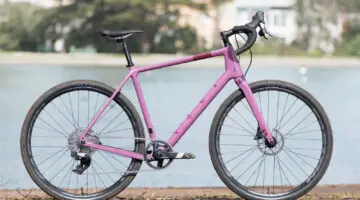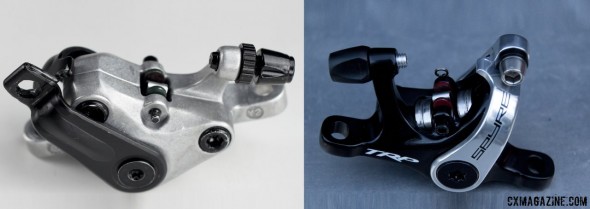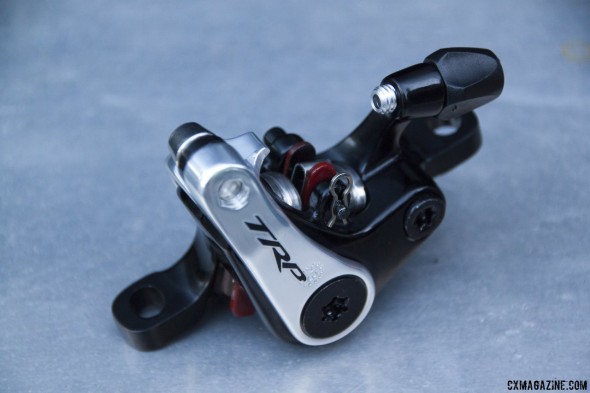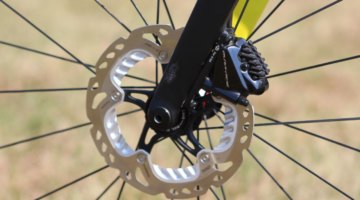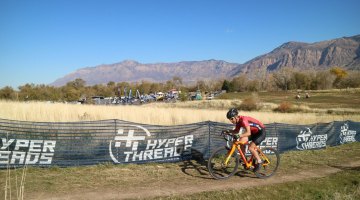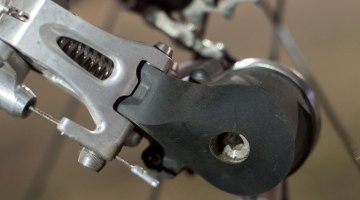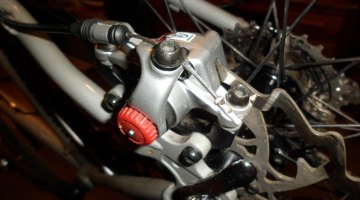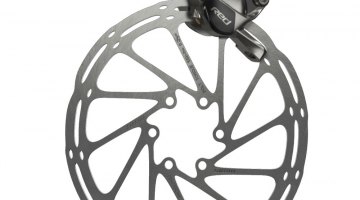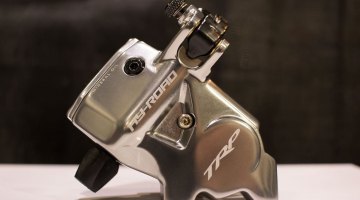by Andrew Yee
On Tuesday, I had the opportunity to ride with the TRP HY-RD hydraulic disc brake and the Spyre dual piston mechanical disc brake, both designed for road and cyclocross bikes. I shared my impressions on the impressive HY-RD on Tuesday, and took some extra time to write up the Spyre review after feeling the need to do a fair comparison with its main competition, the Avid BB7, as opposed to its more powerful brother, the HY-RD.
Dual Pistons – What’s the Big Deal?
Back in July 2012, we were hanging around the TRP Brakes booth at the 2012 Dealer Camp in Park City, Utah, and spied a very early prototype of a dual piston mechanical disc brake and snapped a few photos while the TRP staff was busy talking with dealers. Unfortunately for you readers, the prototypes weren’t intended for public viewing, and thus we honored TRP’s request to not publish the photos at the time (several of them are now below and in our gallery). Fast forward nine months later, and we can see the final product and how much progress the company has made in refining this design.
Dual pistons means both pads can move in and out, as opposed to just the outboard pad on single piston designs seen on the Avid BB7, BB7 SL, Hayes CX5 and Shimano CX75 mechanical disc brakes that are the most popular options on cyclocross bikes. Dual pistons are commonplace on hydraulic disc brakes, including the recently launched SRAM Red hydraulic disc brakes (stay tuned for our early ride impressions), and TRP’s own HY-RD hydraulic disc brakes we also tested earlier this week.
Dual piston mechanical disc brakes are not a revolutionary design, with companies like Gussett offering such a design with their dual piston, 290g Chute brake for several years. With the explosion of disc brake cyclocross bikes, the demand for a lighter version for weight-conscious racers has pushed TRP to develop their own design.
Let’s address some common misconceptions about the benefits of a dual piston mechanical disc brake right away. First, dual pistons do not mean double the braking power, as your braking force applied to the brake lever just splits between the two levers pads instead of being applied to one pad. Small gains in braking power should be possible because you don’t spend your braking effort flexing a metal rotor, but your braking power isn’t doubled.
Second, although both pads move in and out, it’s not as though there’s double the clearance between the pad and rotor. Doubling pad clearance without a Servo Wave-type brake lever or a complicated pivot that offers non-linear pad movement would mean half the mechanical advantage, or much lower braking power. Instead, the pad clearance essentially is spread out more evenly on either side of the rotor instead of being offset to keep the non-moving pad close to the rotor on a design like the Avid BB7 caliper.
TRP’s Lance Larrabee says the Spyre does offer more pad clearance than the BB7 caliper, although he didn’t have hard numbers. He also said their tests showed the brake offers 20% more braking power than the popular Avid design as well. That gain could be due to better pad materials, better lever arm geometry, or reduction in braking force because the rotor doesn’t have be flexed.
Brake pad clearance is impacted by brake lever choice just as much as caliper design, as newer Shimano STI levers pull 20% more cable, and V-brake compatible drop bar levers pull even more. But does pad clearance really matter? We’re not so sure. Although it’s disconcerting to hear the rotor scrape mud and grit when things get sloppy, a few mm of extra clearance may only delay such noise by a few seconds as the grit accumulates. Ben Berden told Cyclocross Magazine at the TRP launch that the noise of a rotor scraping against grit was the one thing that really took some getting used to when he switched to disc brakes, but said it was mostly psychological and the late-braking ability was well worth it.
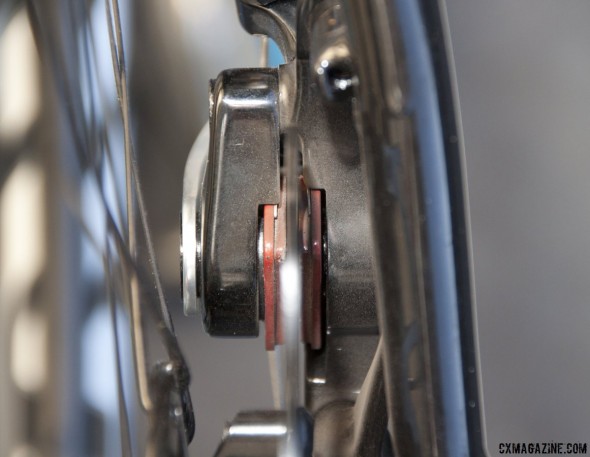
Both pads move on TRP Brakes’ Spyre Mechanical Disc Brake, but clearance isn’t dramatically greater. © Cyclocross Magazine
What dual pistons should offer is an improved pad life, since there’s not one stationary pad to get more scraped by the rotor in gritty conditions. It also should allow tool-less, quick pad adjustments, perhaps even while riding if you use an inline barrel adjuster near the handlebars. If anyone raced the wet race at Manzanita Park at the CCCX series in NorCal, or Nationals in Verona, Wisconsin, and experienced levers-to-the-bars brake disc brake fail, you’ll appreciate this option.
Double the Pistons, Shave Some Grams
Going to dual pistons does not mean that the more-complicated mechanical structure has to be heavier, and TRP focused the last year on sculpting and optimizing the design for weight savings while still hitting its price points. The $80 per wheel standard Spyre model, at just 158g per wheel, saves 20g per wheel over a standard Avid BB7 brake, and 40g per wheel over the Hayes CX5 mechanical disc brake (reviewed in Issue 20). $40 more per wheel will get you a carbon lever arm, and save you 9g with the SLC model. It’s worth noting that there is lighter competition than the mentioned brakes, and as fully reviewed in Issue 20, Avid’s BB7 SL, with titanium bolts and aluminum-backed pads, at 161g, weighs 3g more and at $170 per wheel costs more than twice the price of the Spyre. Shimano’s CX75 cyclocross disc brake is slightly lighter, weighing 154g per wheel, but at $75 per wheel without rotor is more expensive as well. And both brakes have only half the number of pistons, in case you’re counting grams per piston or dollars per piston.
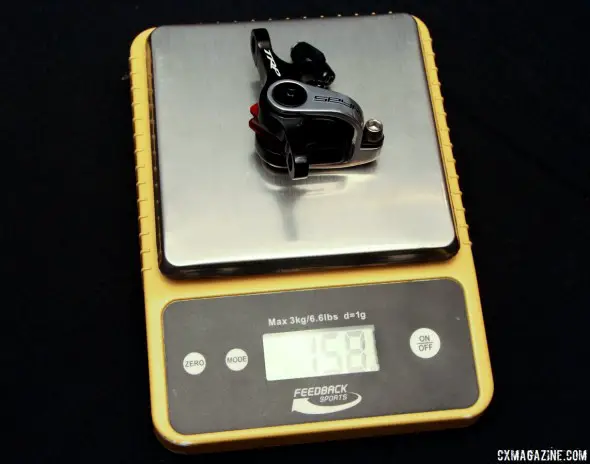
The TRP Brakes’ Spyre is 20g lighter than the standard Avid BB7 and on par with the BB7 SL and CX75 brakes. © Cyclocross Magazine
The above weight differences are for calipers alone, but we haven’t found a huge difference in OEM rotors. There are opportunities to save grams via the rotor, with Kettle Cycles’ carbon rotors being an extreme example, but pad wear, heat dissapation and braking power can be compromised.
Setting Up
Although we didn’t set up the brakes ourselves, you may have to, and we have some observations from watching the TRP team install the brakes and from studying the features. First, although the TRP Spyre lacks the Tri-Align conical washer system that Avid has patented, there’s sufficient room built into the caliper’s bolt holes to offer lateral adjustment to accommodate differences in frame, fork and wheel tolerances, assuming both the rotor and caliper are aligned on the same plane.
Pad adjustment can happen in two ways, by adjusting the outboard pad with a 3mm hex wrench, and simple tool-less adjustment of cable tension with the barrel adjuster, which obviously would move both pads in or out, simultaneously. If you’re running one set of wheels, installation should be easy, but switching race wheels could mean you have to play with the mounting bolts to avoid rotor rub if your wheels and rotors aren’t close in tolerances, which unfortunately can happen, especially if you’re mixing brands of hubs and rotors between race and training wheels. Avid BB7 users may miss the Spyre’s lack of tool-less pad adjustment, but may appreciate the more svelte design and weight savings. Read on for our afternoon ride impressions.

